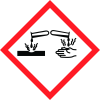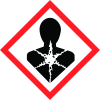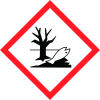Spectroquant
Merck Chemicals Ltd
Revision date : 2021-10-22



Note: Ingredients listed on restricted chemical lists
EC/CAS
7783-35-9
Name of the chemical
Mercuric sulfate
Concentration
N/A
EC/CAS
7778-50-9
Name of the chemical
Potassium dichromate
Concentration
N/A
General Information
Revision date
2021-10-22
Product name
Spectroquant
REACH No
This
Emergency telephone
+49 (0) 6151 722440
Icons in SDS
Company Information
Company name
Merck Chemicals Ltd
E-mail address of the competent person responsible for the Safety Data Sheet
prodsafe@merckgroup.com, information@merckchem.co.uk
GHS Information
Signal word
Danger
Hazard Codes
Hazard statements (CLP)
H290, H314, H318, H340, H350, H373, H400, H410
Hazard statements
Code
Statements
H290
May be corrosive to metals
H314
Causes severe skin burns and eye damage
H318
Causes serious eye damage
H340
May cause genetic defects
H350
May cause cancer
H373
May causes damage to organs through prolonged or repeated exposure
H400
Very toxic to aquatic life
H410
Very toxic to aquatic life with long lasting effects
Precautionary statements
Code
Statements
P202
Do not handle until all safety precautions have been read and understood.
P273
Avoid release to the environment.
P280
Wear protective gloves/protective clothing/eye protection/face protection.
P303+P361+P353
IF ON SKIN (or hair): Take off Immediately all contaminated clothing. Rinse SKIN with water [or shower].
P305+P351+P338
IF IN EYES: Rinse cautiously with water for several minutes. Remove contact lenses if present and easy to do - continue rinsing.
EUH-statements
Code
Statements
EUH208
Contains <name of sensitising substance>. May produce an allergic reaction.
Section 2
CLP CLASSIFICATION
COD Corrosive to metals, Category 1, H290 Skin corrosion, Sub-category 1A, H314 Serious eye damage, Category 1, H318 Germ cell mutagenicity, Category 1B, H340 Carcinogenicity, Category 1B, H350 Specific target organ toxicity - repeated exposure, Category 2, H373 Short-term (acute) aquatic hazard, Category 1, H400 Long-term (chronic) aquatic hazard, Category 1, H410 For the full text of the H-Statements mentioned in this Section, see Section 16.
2.2 Label elements
Labelling.(REGULATION (EC) No 1272/2008)
Signal word
Danger Danger
Hazard statements
H290 May be corrosive to metals. H314 Causes severe skin burns and eye damage. H340 May cause genetic defects. H350 May cause cancer. H373 May cause damage to organs through prolonged or repeated exposure. H410 Very toxic to aquatic life with long lasting effects. H340 May cause genetic defects. H350 May cause cancer. H314 Causes severe skin burns and eye damage.
Prevention
P202 Do not handle until all safety precautions have been read and understood. P273 Avoid release to the environment. P280 Wear protective gloves/ protective clothing/ eye protection/ face protection/ hearing protection.
Response
P303 + P361 + P353 IF ON SKIN (or hair): Take off immediately all contaminated clothing. Rinse skin with water. P304 + P340 + P310 IF INHALED: Remove person to fresh air and keep comfortable for breathing. Immediately call a POISON CENTER/ doctor. P305 + P351 + P338 IF IN EYES: Rinse cautiously with water for several minutes. Remove contact lenses, if present and easy to do. Continue rinsing. Restricted to professional users. EUH208 - Contains: potassium dichromate May produce an allergic reaction. COD Reduced labelling (≤125 ml)
Precautionary statements
P202 Do not handle until all safety precautions have been read and understood. P280 Wear protective gloves/ protective clothing/ eye protection/ face protection/ hearing protection. P303 + P361 + P353 IF ON SKIN (or hair): Take off immediately all contaminated clothing. Rinse skin with water. P304 + P340 + P310 IF INHALED: Remove person to fresh air and keep comfortable for breathing. Immediately call a POISON CENTER/ doctor. P305 + P351 + P338 IF IN EYES: Rinse cautiously with water for several minutes. Remove contact lenses, if present and easy to do. Continue rinsing.
Contains
sulphuric acid, mercury(II) sulphate, potassium dichromate
2.3 Other hazards
None known.

